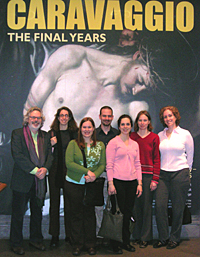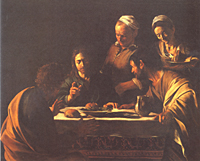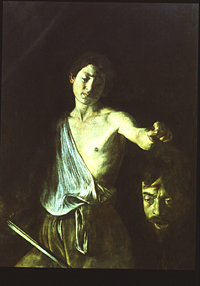

UDaily is produced by the Office of Public Relations
The Academy Building
105 East Main St.
Newark, DE 19716-2701
(302) 831-2791
|
 |
UD prof plays major role in Caravaggio exhibitions
 |
| David M. Stone, associate art history professor at UD, at the National Gallery in London with doctoral students (from left) Erika Suffern, Christa Aube, Scott Mangieri, Molly Zillman, Sarah Bavelli and Lorena Baines |
3:51 p.m., April 21, 2005--Two weeks after his return from London’s National Gallery, David M. Stone, UD associate art history professor, still relishes his involvement with the internationally renowned “Caravaggio: The Final Years” art exhibit.
A leading authority on Caravaggio’s later works and a foremost scholar on the social and religious contexts within which the 17th-Century Italian painter worked, Stone contributed a major essay and coauthored two full-length entries to the exhibition catalog and gave two sold-out lectures during his recent visit to the National Gallery.
Stone, though on sabbatical this semester, had the idea of bringing Ph.D. students in Baroque art to London, and secured funds for this purpose. Supported by matching grants from UD’s College of Arts and Sciences, the Department of Art History and the Center for International Studies, six UD graduate students had their airfare and lodging paid for, allowing them to spend four days with Stone in London this past March.
“We had a very active program,” Stone said of the experience, emphasizing that for two mornings of the visit he and the students had the gallery to themselves for scholarship purposes.
“One morning we toured the exhibit with just Dawson Carr [the curator of later Italian paintings at the National Gallery], and we learned about the technical and conservation problems posed by each piece. Another morning, we participated in the hour-and-a-half that the National Gallery sets aside just for scholars and other people closely connected with the art history world,” he said.
“In the current state of Caravaggio mania in London, that was a great stroke of luck. If you had any concept of how popular this show was, your jaw would drop.”
Comprised of 16 later works by the notoriously hot-blooded artist, the traveling show, “Caravaggio: The Final Years,” Stone explained, is the first exhibition ever to gather so many of Caravaggio’s late works under one roof.
 |
| Supper at Emmaus, oil on canvas, 1606 |
Before its run at the National Gallery, the exhibition also enjoyed a stay at the Capodimonte Museum in Naples, Italy, where it was equally successful. Stone gave a conference paper there in December. In London its acclaim is so widespread, Stone said, “every single day by 10 o’clock the National Gallery puts up a sign on the counter telling visitors the show is sold out.”
Its accompanying exhibition catalog, which has already sold well over 20,000 copies in the English and Italian editions, contains Stone’s essay on the artist’s Maltese period (1607-1608): “Caravaggio Paintings for the Sacra Religione.”
Additionally, Stone’s two lectures--one about a late Caravaggio portrait of the Grand Master of the Order of St. John, and the other about the famous Caravaggio painting of a slain John the Baptist--showcased his groundbreaking scholarship on the quixotic artist.
“Caravaggio is the most interesting personality of 17th-Century Italian painting,” Stone said, “and because of the contrast between violence and poetry in his art and the contrast between violence and artistic genius in his life, viewers are incredibly intrigued by him.”
Well-known for his passionate side in both art and life, Caravaggio fled Rome after killing a friend and rival in 1606. After establishing a successful career as an altarpiece painter in the then-Spanish-controlled Naples, he fled to Malta, an arid island in the middle of the Mediterranean. In this self-imposed exile, he again reinvented himself by producing a stylized body of work that was funded by only one discrete group of patrons--members of the Order of the Knights of St. John, an international brotherhood of professed Catholic nobles who ruled Malta.
This tortuous history and the forces that motivated it lie at the core of Stone’s scholarship. He has spent years conducting research in the archives of the Order in the National Malta Library and has received several prestigious fellowships for his work.
“The later career of Caravaggio is one of the greatest stories in 17th-Century art,” Stone said. “And, because you have an unusual situation where you can sees an artist working for a long time with a discrete group of patrons in a remote place, you have almost a perfect test case for patronage studies.”
“When an artist works for numerous patrons simultaneously, it is hard to tell how much of the painter’s style and iconography is due to this cardinal or that church or to such-and-such a private patron. But Caravaggio worked on an island for 15 months under the exclusive patronage of the Knights of Malta,” he said.
 |
| David and Goliath, oil on canvas, 1606 |
Stone’s well-known research into this “test-case” situation was the impetus behind his being selected as one of the contributing essayists for the exhibition catalog.
After being approached by the three exhibition organizers, Keith Christiansen, curator in the Department of European Painting at the Metropolitan Museum of Art in New York; Nicola Spinosa, superintendent of the Naples Museums; and Carr, Stone flew to Malta this past summer to edit his contributions in collaboration with fellow Caravaggio scholar, Keith Sciberras. Their collaboration on the entries was such a success that a spin-off, an in-depth article they wrote on Caravaggio’s painting of St. Jerome (Co-Cathedral of St. John, Malta), will be published this month in the prestigious Florentine art history journal Paragone.
Much of the material in the essay comes from research carried out over the past few years for Stone’s upcoming book, Caravaggio and the Knights of Malta, a comprehensive study of Caravaggio’s Maltese period, due to be published within the next two years.
“I put everything I had into the essay, because how often do you have the perfect situation in which you get to be a part of a magnificent, historically significant exhibition?” he said. “I knew how many people were going to read the catalog.”
Article by Becca Hutchinson
Photos courtesy of David M. Stone
 E-mail this article
E-mail this article
To learn how to subscribe to UDaily, click here.
|
 |

|

